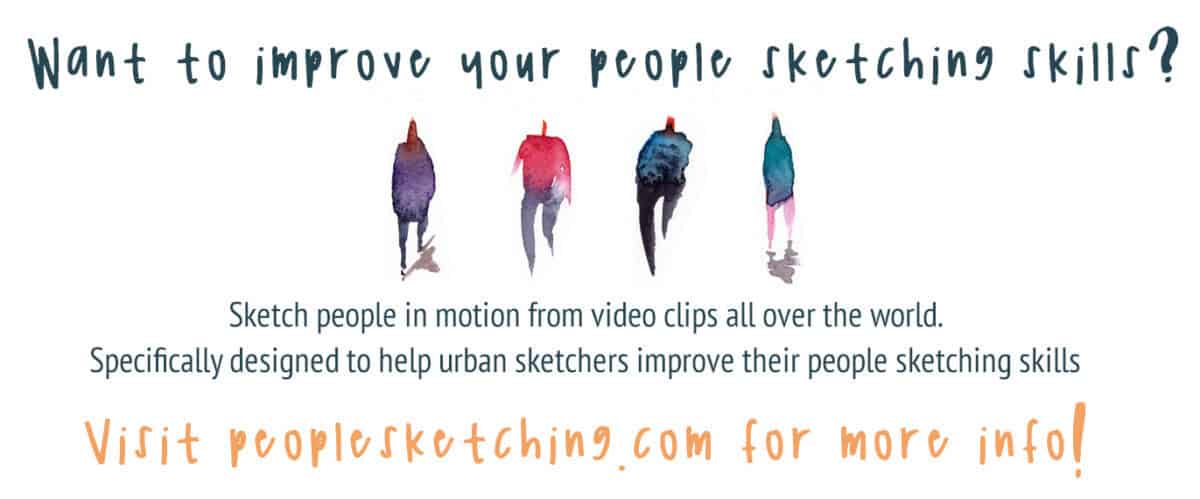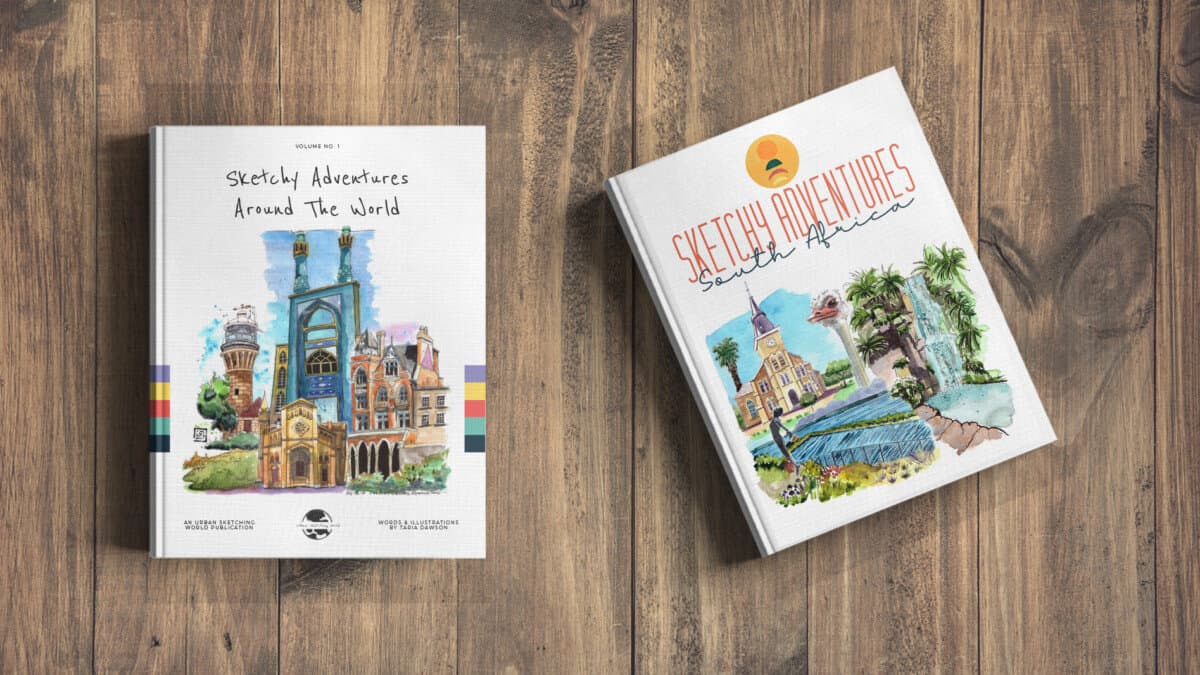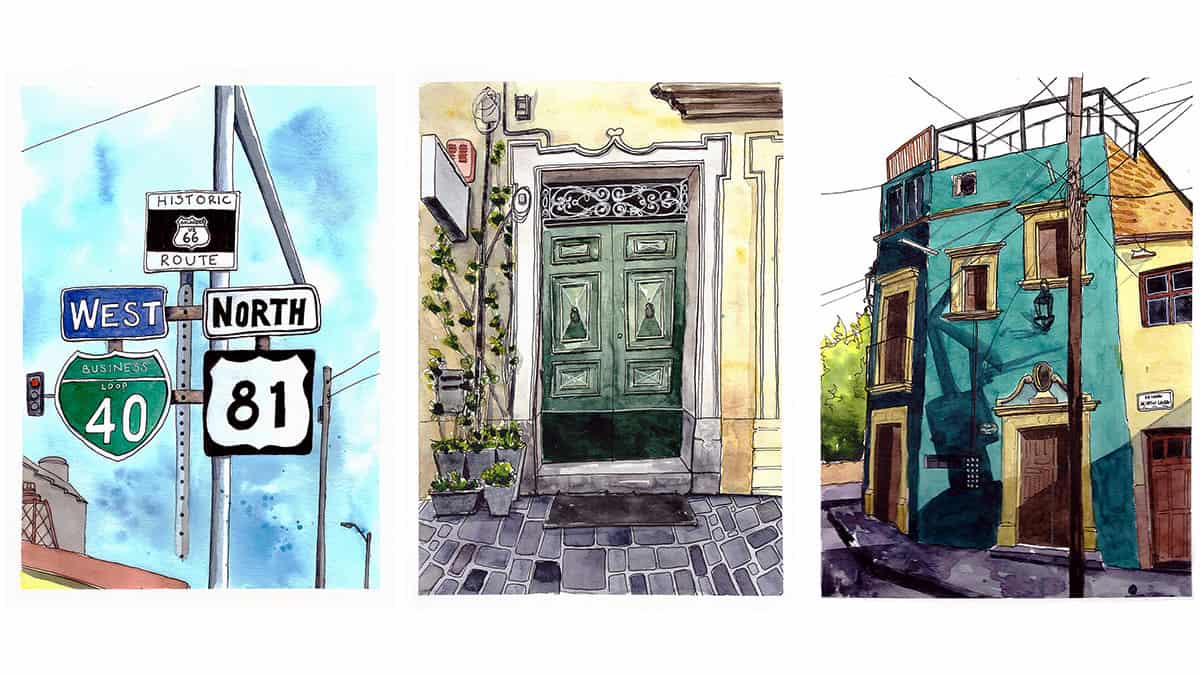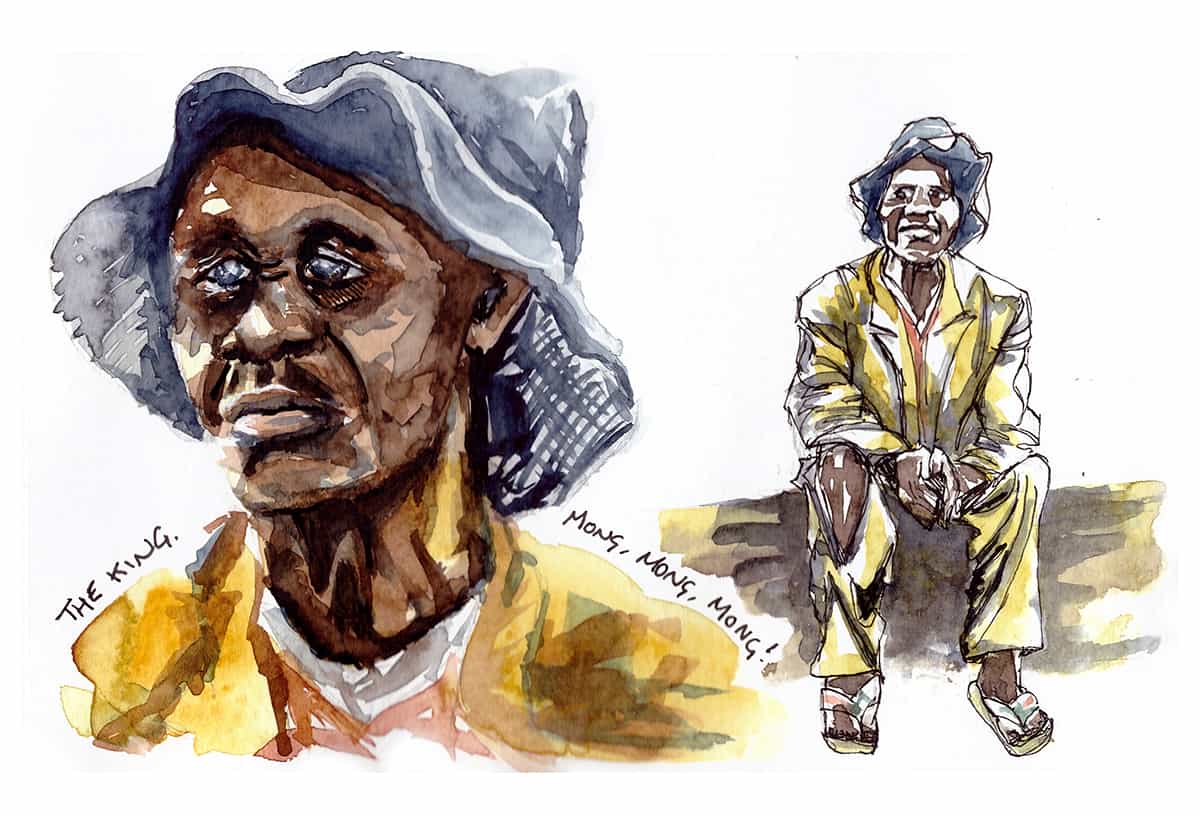In the context of urban sketching, we could be talking about two major angles when discussing people sketching:
- A person or people are the main focus of the sketch
- Adding people to your sketch of a larger scene that’s predominantly focused on architecture
In this post, we shall discuss point 1, where the focus of the sketch of a person or people, rather than including figures in an urban sketch of a scene.
For a more in-depth discussion of point 2, check out my post “adding figures to your urban sketches”.
This post pulls together everything about people sketching I have researched from the best resources I could find as well as my own experience. We will look at what people sketching is, examples and advice from prominent urban sketchers, the best video tutorials on people sketching and how to start practising out on location.
The aim of this post is to be an overall guide to people sketching which you work through and can keep referring back to over time.
What is people sketching?
Sketching people, in the context of this post, is different from drawing a portrait, or rendering full anatomically correct figures like you would in a life drawing class.
Urban sketchers record the world around them. While some sketchers purely focus on a singular piece of architecture that captures their attention, others like to render entire street scenes and others are more interested in capturing the people around them.
As mentioned, this does not mean a portrait of their face, it may not bear too much resemblance to the person in front of them. In fact, some sketchers blend several people into one person if their subject moves before they’re finished.
Sketching people in this context is about capturing a person in that space and time, doing whatever it is they are doing. It may be one person or a group of people.
Koosje, a co-founder of Sketchbook Skool, demonstrates merging different people into one in her video below about reportage sketching. She goes to a coffee shop to document the people there but obviously people at the counter order their coffee and move off so she shows how she morphs or blends one person into another. It’s not the resemblance of a person that’s important, it’s the story.
Before we talk about how to approach practising people sketching I think it’s a good idea to look at some examples of the variety of ways different urban sketchers capture the human form and their story.

People Sketching Examples & Advice from Urban Sketchers
Let’s talk about some people sketches by some of my favourite urban sketchers.
Looking at other people’s work, trying to understand their techniques and how they approach their sketches can help us to inform our own practice.
Lynne Chapman
My favourite ‘people sketcher’ is Lynne Chapman. Based in Sheffield, UK, her sketches of commuters on trains drew me into the world of sketching people. It’s still not a skill I have mastered…or even practised much. I’m a bit overwhelmed when it comes to people. Give me a building any day. There is just something so wonderful about people sketching, I’m captivated. It’s certainly something I want to dedicate a lot more time and energy to.
It’s not the most realistic sketches of people that grab my attention, in fact, they are almost less likely to hold my attention. I am not that interested in realism. It’s the sketches that capture the spirit and the energy of the person that I am interested in.
How can I know about that person’s energy/spirit when I don’t know the person?
It’s almost indescribable (not useful for a blog post, I know) – it’s just a feeling I get.
You know what I mean right?
Right?
Lynne Chapman has a book called ‘Sketching People: An Urban Sketchers Manual to Drawing Figures and Faces’ which is available on Amazon. I actually found it in my local library in Wimbledon (London) a few years ago so if you’re short of cash and you have access to a library it’s definitely worth checking there! If you are serious about developing your people sketching skills, this is an amazing book, especially if you’re a fan of Lynne’s style of illustration.
Check out my ebooks with hundreds of ink & watercolour travel sketches from all over the world. Get some inspiration for your next trip…

Marc Taro Holmes
Marc Taro Holmes, along with Liz Steel, hosts a sketching challenge each year called “One week, 100 people”. As the name suggests, the challenge is to try and sketch 100 people in the space of one week.
Marc’s way of trying to fit sketching this many people into one week is to carry around a small (A6) sketchbook and draw in it with a fineliner pen (either a fountain pen or a technical pen like the Microns for example) as well as a brush pen for the shadows.
Marc recommends everyone start off this way, with simple materials that you can grab out of your pocket at a moment’s notice. This helps you stop agonising over your sketches as you only have a thin and thick line to work with. Because of this, you can focus on the storytelling aspect of your people sketches.
Marc’s approach to sketching people quickly is his ‘head and hands’ technique. He focuses on capturing these two elements first – who are they and what they are doing. Everything else comes later if there’s time. This is a really interesting take on how to sketch people quickly from life and capture the most important elements of the ‘story’.
When Marc is sketching just the heads of people, he advises focussing on the head shape and the hair shape – if you can get these shapes, then you can fill in the rest of the details and achieve a convincing sketch.
Marc has a Craftsy course called “Sketching People in Motion”. This was the first course I bought on the platform many years ago. It’s an excellent overview of how to sketch people and I’d really recommend checking it out.
Marc also has a great book about urban sketching called The Urban Sketcher: Techniques for Seeing and Drawing on Location.
If you want to practice sketching people in motion but from the comfort of your own home, check out peoplesketching.com where you’ll find hundreds of videos of people that you can practice sketching from.
Want to learn travel sketching in ink & watercolour?
Check out my course, Sketch Your Adventures and for a limited time get 50% OFF!!!

Adebanji Alade
Adebanji Alade was one of the first artists I came across who sketches people on public transport. I love the way he layers people’s faces across his sketchbook. He is not precious, you can see he is just sketching constantly to practice and improve.
Adebanji is one of the most prolific sketchers I’ve come across. He sketches obsessively. He is a self-proclaimed addict (to sketching). This leads me to mention he has just released a book, ‘The Addictive Sketcher’ which you can find on Amazon or if you want a signed copy, you can order directly from him here.
Adebanji has loads of Youtube videos, you can see him flip through one of his people sketching sketchbooks below:
If you want to see more photos of Adebanji’s sketches of people on public transport you can check out this page on his website.
Dwayne Bell
Dwayne Bell is a senior lecturer in Illustration at Cumbria University in the UK. His Instagram feed is full to the brim with sketches of commuters, generally on the bus, which Dwayne sketches on his journey to and from work.
Dwayne tends to sketch in a small Leuchturm 1917 sketchbook with a Lamy Safari fountain pen.
You can take a look through Dwayne’s sketchbooks here and if you want you can even purchase a copy of his sketchbook here.
Dwayne also produces super interesting reportage projects, for more information you can check out my post on reportage illustration here.
Don Colley
Don Colley is another one of my favourite people sketchers. In the video below he explains how he deals with sketching someone who is constantly moving. He shows his sketchbook page of one guy in a library and the different poses over time.
Don is endorsed by/represents Faber Castell. He is a big fan of their Pitt Artist pens to produce his people sketches. He uses an interesting technique where he smudges the ink with his thumb while it’s still wet. With this technique, he can achieve cool textures, whether on the skin or clothing.
Alvin Mark
I really enjoy Alvin’s Youtube videos showing him sketching people out and about in Singapore.
In the video below Alvin gives his 5 hacks to sketching people. While some of his advice is a bit obvious, some of the information is really useful. Simply just watching his time-lapse demonstrations is super interesting.
How to Get Started with People Sketching
There are many approaches to people sketching. You may wish to focus primarily on the face of a person like Lynne Chapman does in her commuter sketches. Or on the head and the hands like Marc Taro Holmes does in order to capture the story of what someone’s doing. Or perhaps you want to capture full figures in an abstracted way. As you’ve seen there is a magnitude of ways to go about sketching a person or people.
You could try:
- contour lines with a fountain pen, like Dwayne Bell.
- contour line and add shading with a grey marker (or diluted ink) like Adebanji Alade
- contour line and a black brush pen like Marc Taro Holmes
- watercolour silhouette like Trevor Waugh (see below)
Contour Drawing
When we are drawing people in day-to-day life, we don’t need to get anatomy entirely accurate. The fact they are wearing clothes masks some of the difficulties of anatomy and means we can actually get away with sketching the outline or contours of the clothes in order to form an accurate shape of the person.
I really enjoyed this video below by Patrick Ley-Greaves in which he demonstrates his ‘outlining technique’ when drawing people.
I think this is a fun way to start drawing figures. Practice from some photos (or videos which you can find on peoplesketching.com) and see if this method works for you. The super fun part is adding the watercolour afterwards. It’s amazing how these sketches look with a bit of colour added. Notice that Patrick adds some cast shadows to anchor the figure to the ground. This is an important part and something that is mentioned in the videos I share below.
Patrick is also a teacher on Skillshare, he has 30 years of experience painting in watercolours and on location, you can join Skillshare with this link and get a trial of premium membership for free.
Some of my favourite online classes
- Sketching People with Watercolour – Marcus Penna
- Watercolor Travel Journal – Alicia Aradilla
- Artistic Watercolour Sketching: Dare to Sketch – Felix Scheinburger
- Intro to Portrait Sketching: Draw in Real-Time – Bill Robles
Capturing Proportions
Another factor which is key to capturing people convincingly is getting the lines of the shoulders and hips to convey the weight of the body. For example, someone may have their weight predominantly on one foot while they are standing still.
How does this affect the lines of the body?
You’ll find that when the shoulders are slanted in one direction, the hips will slant in the opposite direction. The way someone holds their posture can be very distinctive, it’s certainly something to look for when capturing figures.
Liron Yanconsky has a number of videos on people sketching. In the video below he really starts from the beginning, showing a similar outlining procedure to that of Patrick in the section above but also focussing on proportions.
Sketching proportions by constantly referencing elements and their spatial relation to other points in your sketch is such a valuable skill to develop and really helps to get things like perspective correct without having to know any of the rules (always handy)!
Watercolour Silhouettes
This is a really quick and beautiful way to capture figures. In the video below Anne Laure demonstrates how you can simply capture small silhouettes in both ink and in watercolour. Skip to the 17 min 40 mark for the watercolour section.
For further inspiration sketching silhouettes purely in watercolour check out Trevor Waugh’s video below, there’s no instruction, it’s just a video of him painting many of these types of watercolour figures.
However, in part 2, Trevor talks about his materials and how to achieve these watercolour figures:
Trevor has some great pointers to help guide you to start painting people directly in watercolour:
- Don’t make the head too big
- Focus on the proportions of the figure
- Utilise brush pressure – light pressure for small details and more pressure for larger areas such as the body.
- Let colours merge naturally on the paper
- Cast shadows help to anchor the figure on the ground
When you’re ready to take your watercolour silhouettes to the next level and add them into a full painting or scene, make sure to check out Trevor’s later 2 part video on how to do this. It’s not strictly something you may do as an urban sketcher but studying artists’ techniques across all disciplines can only help your urban sketching skills improve. Especially when it comes to watercolour techniques.
Where & How Do You Draw People in Public?
- Choose a crowded place where people are unlikely to notice you
- Find a place where you can sit with your back to a wall or somewhere people cannot pass behind you and see what you’re doing
- Observation of your subject is key but be subtle – sunglasses could work if appropriate
- Use a small sketchbook, and balance it on your bag to keep it a little more out of sight
- Limit the materials you use, just use a pen or pencil, you can add colour later if you want
- Draw your friends – if you’re sitting around a table at a cafe, restaurant or in a park and hanging out, this is a good time to practice. You can obviously tell them what you’re doing, they’re more likely to not mind seeing as they know you!
- Draw friends or family members when you’re sitting around watching TV, they are more likely to be still too.
- Draw yourself sitting in front of a mirror.
- Draw someone when they’re driving
- Draw people while you’re in a waiting room such as for the doctor or dentist. This really helps to pass the time.
- Sketch commuters. I think this takes a bit of bravery, especially on the London Underground (tube) as people are crammed in so it’s easy for people to see what you’re doing. If you have more spacious public transport go for it. I find a ‘back of the head’ sketch just as intriguing as a sketch where you can see someone’s face.
- Remember Marc Taro Holme’s advice to capture the story of what someone is doing quickly – focus on the head and the hands.
The Ethics of People Sketching
Should you ask permission before sketching someone in public?
Most sketchers do not ask permission before sketching people. This is for multiple reasons.
- It’s a quick sketch for a few minutes and then the person is gone
- There’s not much resemblance so its not really much of an imposition
- People tend to stop acting naturally when they know they are being focussed on
- If you don’t say anything, most people don’t even notice you’re sketching them – so there’s no need to make them feel awkward
- Be sensible about who you are drawing: choose people further away from you, people who are very distracted by their phone or conversation, or people asleep, such as on a train or bus!
The only urban sketcher I have heard of that asks permission is Ian Fennelly but he very rarely tends to draw people, 90% of his sketches are of architecture.
Koosje from Sketchbook Skool actually covers this exact question in her video below:
Is it considered a bit strange to sketch strangers in a public place?
It’s not strange to sketch people in real life. It’s not the same thing as walking around taking photographs of people, which street photographers do! For a start, your sketch of someone is not going to depict the person accurately, no matter how good you are! Your sketch will only ever be an interpretation of that person.
Artists throughout the ages have sketched people from life. There’s no better training ground for capturing human poses than trying to sketch people quickly ‘in the wild’!
As per the advice above, be sensible and subtle as to who and where you’re sketching. I people do notice and look uncomfortable, stop drawing. Sometimes people may come over to you and start up a conversation about what you’re doing. All you need to say is that you’re studying art and you have been set an assignment to capture human poses from life. There are not many people who could really be upset with that explanation.
Further Reading & Courses About People Sketching
Courses
Skillshare
If you have read some of my other posts you may know I am a big fan of Skillshare. James Richards has a great course about how to add figures into your urban sketches. For a free trial of premium membership, you can sign up here. That means you can watch as many classes on the platform for free before the free trial ends at which point you can cancel or if you love it (like I do) you can carry on and pay month by month.
Craftsy
There are two courses I have taken about people sketching by two fantastic urban sketchers. These courses are of a super high standard and worth every penny.
- Sketching People in Motion – Marc Taro Holmes
- Figure Sketching Made Simple – Suhita Shirodkar
Sketchbook Skool
I’m also a big fan of Sketchbook Skool and everything they do. They offer a course called ‘People Drawing People’ which looks really good. It features one of my absolute favourite sketchers, Felix Scheinburger. Along with other firm favourites such as France Van Stone and Vin Ganapathy.
I have not taken this course but Sketchbook Skool generally offers a very high standard of teaching so I’m sure it would be a good purchase if you like the look of the trailer below:
Books
5 Minute Sketching People – Super-Quick Techniques for Amazing Drawings by Pete Scully
The Addictive Sketcher by Adebanji Alade
Sketching People: An Urban Sketchers Manual to Drawing Figures and Faces by Lynne Chapman
How to Sketch People by Liron Yanconsky
Final Thoughts
I hope this guide pulling together my favourite people sketching resources has been useful and inspires you to get out and start sketching humans in the wild! I know I’m keen. If you post your people sketches on Instagram make sure you tag @urbansketchingworld
If you want more urban sketching news, inspiration and to be kept up to date with my personal urban sketching projects make sure you join my newsletter but popping your email address in the box below. I email once a week.


Comments are closed.